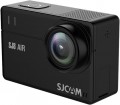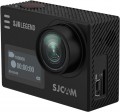Dust-, moisture-proof of case
The degree of dust and water protection of the protective case supplied with the camera.
Protected case will save your camera from dust, water, temperature changes, shocks, etc. The specific degree of protection is indicated according to the international IP (Ingress Protection Rating) system, according to which each device is assigned a code of the form IPXX, where X is replaced by specific numbers. The first of them characterizes the protection against the penetration of foreign objects (from 0 to 6, where 0 is no protection). Usually, in boxes for action cameras, this indicator does not go below 5, because otherwise the container would have too large gaps, and its use simply would not make sense. Level 5 provides dust resistance — dust can get inside the case, but in small quantities that do not affect the device inside. Level 6 corresponds to complete imperviousness to dust.
The second digit is protection against liquid ingress (from 0 to 8, where 0 is no protection). Usually, the minimum level of protection against water is 6.
6 — protection against short-term immersion (for example, falling into a sea wave);
7 — protection against temporary immersion under water (up to 30 minutes) to a shallow depth (up to 1 metre), without continuous operation in immersed mode;
8 — protection against immersion to a depth of more than 1 metre for a time of more than 30 m, with the possibility of continuous
...operation underwater. The specific level of protection of level 8 can be quite impressive — up to the possibility of diving to several tens of metres.
Note that protective cases for action cameras can be sold separately. Therefore, if the capabilities of the complete container do not suit you, there may be a more secure case on the market. On the other hand, in general, it is still more convenient to buy such an accessory immediately with a camera — so as not to waste time and effort on choosing the right protective case.HD (720p)
The ability of the camera to record HD video (720p).
The official HD specification provides a resolution of 1280x720. However, in action cameras, there may be resolutions slightly different from this parameter, for example, 1080x720 or 1440x960. Anyway, HD is the most modest of today's high-definition standards, which, nevertheless, provides a fairly clear and detailed image.
Another important parameter given in this paragraph is the frame rate. The higher it is, the smoother the movement in the frame will be, and the details in dynamic scenes will be visible clearly. Technically,
30 fps or even less is enough for video, but
60 fps is considered the perfect value — at this frame rate, motion blur becomes almost imperceptible and at the same time the size of the captured files remains within reasonable limits. However, there are cameras on the market with higher frame rates at HD resolutions —
100 fps,
120 fps,
200 fps and even
240 fps. This speed is usually used for recording slow-motion video, but such a possibility needs to be specified separately.
Full HD (1080p)
The ability of the camera to shoot Full HD (1080p) video.
The standard image size in this standard is 1920x1080. However, in the case of action cameras, this category also includes some other resolutions that are similar in quality, for example, 1440x1080. In general, Full HD provides a very good balance between image quality, the volume of captured files and the processing power requirements for processing them, which makes this standard very popular in modern video equipment — both in cameras and in TV monitors.
Another important parameter given in this paragraph is the frame rate. The higher it is, the smoother the movement in the frame will be, and the details in dynamic scenes will be visible clearly. Technically,
30 fps or even
less is enough, but
60 fps is considered the perfect value — at this frame rate, motion blur becomes almost imperceptible and at the same time the size of the captured files remains within reasonable limits. However, there are cameras on the market with a higher frame rate at FullHD resolutions —
90 fps,
100 fps,
120 fps and even
240 fps. This speed is usually used for shooting slow-motion video, but the possibility of such shooting needs to be specified separately.
Quad HD
The ability of the camera to shoot QuadHD video.
This standard includes an extensive set of resolutions — from 1440 to 3456 pixels horizontally and from 1440 to 2160 pixels vertically, with almost two dozen intermediate options. It is a rather specific transitional option between the relatively inexpensive FullHD 1080p and the demanding UltraHD 4K, allowing you to shoot higher resolution video than 1080p without significantly increasing the cost of equipment. Note that pure QuadHD resolutions are rare in TVs and monitors, but modern technologies make it possible to comfortably watch videos of this format on any high-resolution screen.
Another important parameter given in this paragraph is the frame rate. The higher it is, the smoother the movement in the frame will be, and the details in dynamic scenes will be visible clearly. For example, a filming speed of
25 fps or
30 fps approximates the standard frame rate in film and television; such an image is quite viewable, but fast-moving objects in the frame will look blurry. With an increase in speed to
60 fps, this effect becomes almost imperceptible. The highest QuadHD frame rate found in modern action cameras is
120 fps; this frequency is used when shooting slow-motion video (as well as models with a frequency of
100 fps) because at a n
...ormal playback speed, 60 fps is enough.Slow motion
Frame rate supported by the camera when
shooting in slow motion.
In general, such shooting is called “high-speed” because it is carried out at an increased frame rate (more than 60 fps). As a result, when played back at normal speed (60 fps and below), the video looks slow hence the name. This kind of slow-motion can be used just for fun, as an artistic technique, and even for scientific purposes — to capture movement that is too fast for the human eye. In any case, the higher the slow-mo frame rate, the more you can slow down the video and the more advanced the camera is in this regard. On the other hand, the higher the frame rate, the more performant the graphics part should be; and this, in turn, affects the price of the device, sometimes quite noticeably.
We also note that slow-mo shooting may be available only at certain resolutions, not always at maximum. These points can be directly specified in the specs of the action camera.
Field of view
For models with several lenses, as a rule, this parameter is indicated for each lens.
Most often (unless otherwise indicated), the specifications indicate the field of view by the diagonal of the frame; in some
ultra-wide-angle lenses it can exceed 180°. A special case is made up of lenses for which a 360° view is declared: this means that the optics cover the entire hemisphere in front of it. Such lenses are found in panoramic and 360-degree cameras (see “Product type”).
In general, the field of view primarily determines what area of the scene is being captured into the frame. Accordingly, the wider it is, the more space the camera captures, and the lower the likelihood that something that is happening will be off-screen. On the other hand, it is worth considering that a strong increase in the field of view leads to distortions of the “picture”, especially at the edges, as well as, to a decrease in the size of visible objects and a decrease in detail. Detailed recommendations regarding choosing a camera based on this parameter can be found in special sources.
Digital stabilization
The presence of a digital (electronic) stabilization system in the camera design.
Any stabilization is intended to compensate for small juddering of the image that occurs due to the instability of the hold in the hands, vibrations from the motor or road roughness (when used in transport), etc.
Digital stabilization is carried out as follows: a reserve area is allocated along the edges of the sensor, which under normal conditions does not participate in the formation of the final image. If the device is being shaken, the camera electronics select certain parts of the image from the reserve and build the image in such a way that in the end, it remains stable.
Compared to other methods of stabilization, digital systems are extremely simple and reliable. Moreover, they are inexpensive and have almost no effect on the weight, dimensions, and price of the camera. At the same time, with this method of stabilization, the effective area of the image sensor is reduced, which can adversely affect the image quality and the amount of noise on it.
Megapixels
The number of megapixels in the action camera sensor, in other words, the resolution of this sensor(1 megapixel is 1 million photosensitive points).
There is an opinion that the higher the resolution, the better the image quality. It is true from the point of view that manufacturers are trying to install high-resolution sensors in advanced cameras. At the same time, there are no strict dependencies here, and from the technical point of view, the number of megapixels determines only the maximum image resolution that can be captured using this sensor. The quality of this picture will depend both on several features of the sensor itself (size, type, special design solutions), and the specs of the camera. So when choosing, you should focus not so much on the resolution of the image sensor, but on the general class of the camera and reviews with examples of footage.
Photo resolution
The maximum resolution at which the action camera can take photos. Specified in pixels horizontally and vertically.
This parameter is directly related to the resolution of the image sensor(see above): the total number of pixels in the photo, usually, corresponds to the number of pixels in the sensor. For example, a photo resolution of 4608x3456 corresponds to a sensor of 15925248 pixels, or approximately 16 megapixels. If the number of pixels in the photo is greater than the claimed resolution of the sensor, then the manufacturer uses software tricks that allow you to improve the photo resolution to a higher one than originally. This reduces the cost of devices but also affects the quality of images.
Theoretically, high-resolution images can provide good detail, but in fact, much depends on the specs of the sensor (primarily physical size) and image processing features.

